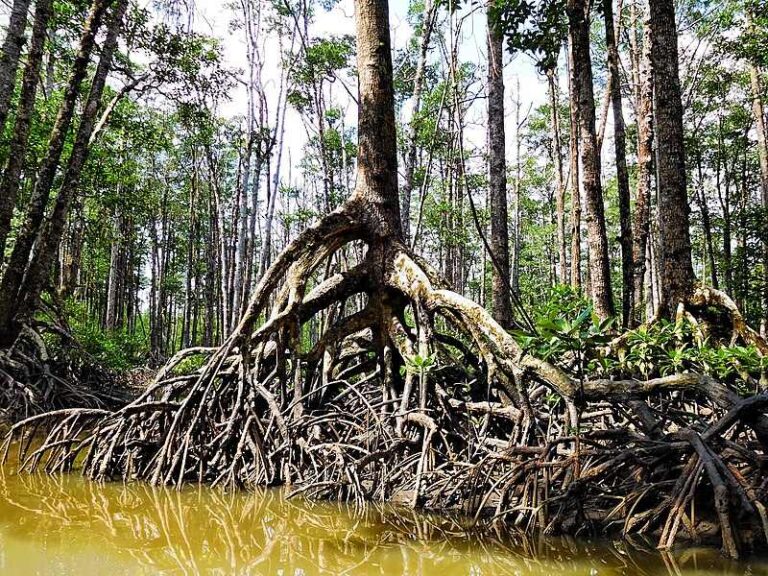Energy Pyramid Meaning, History, Trophic Levels, and Advantages
The energy pyramid is a pictorial representation of energy flow in an ecosystem.
In the elaborate ecosystem that constitutes our entire planet Earth, the energy pyramid is one of the most crucial concepts which must be understood.
This article introduces and defines the concept of the energy pyramid, based the following outline;
-What the Energy Pyramid Really Represents
-Origin and History of the Energy Pyramid
-Basic Structure of the Energy Pyramid: A Brief Look at Trophic Levels
-Energy Dynamics and Losses in the Ecosystem
-A Practical Example of Energy-Dynamics in the Energy Pyramid
-Advantages of the Energy Pyramid
-Other Important Ecological Pyramids
Energy Pyramid Definition
Also known as the trophic pyramid, ecological pyramid, or Eltonian pyramid; the energy pyramid is simply a graphical representation of energy dynamics within an ecosystem.
It shows this energy dynamics in terms of energy stored in, or released from, biomass at trophic various levels of the ecosystem. By showing the dynamics of energy, the energy pyramid also fairly depicts the degree of productivity of the ecosystem. It also serves as a tool by which the amount of energy at each level of the ecosystem, can be estimated.
Another perspective from which we can define the energy pyramid is that of organisms. The energy pyramid is a graphical representation of the dynamic interactions between organisms in an ecosystem.
These interactions which the energy pyramid represents, can also be seen as energy transfer pathways, as they all involve some form of energy transfer. This energy-transfer is the basis of the name ‘Energy’ pyramid. The transfer of energy also helps to identify distinct levels of organic interaction in the ecosystem; referred to as ‘trophic levels’.
What the Energy Pyramid Really Represents
To put it simply, the energy pyramid is designed to show (or to provide an estimate of) the productivity of an ecosystem.
However, there are a few, different factors, which directly determine how productive any ecosystem will be at any given point in time. Therefore, these factors are what the energy pyramid really represents
The factor which is most prominent among these factors which are represented by the energy pyramid, is energy itself.
In order to simplify its representation, the energy pyramid is represented in a series of superimposed levels, layers or bars. While the height of each of these bars is fairly equal to others, the width of the bars varies according to the amount of energy at each level [6].
Also, the bars represent different levels of the food chain in an ecosystem, and hence different species and groups of organisms. This begins from the Primary Producers; also called the ‘autotrophs’ which occupy the lowest level at the base of the pyramid.
Subsequent levels represent organisms which depend directly or indirectly on the primary producers for energy. These are generally referred to as heterotrophs [9].
In addition to representing energy dynamics and organic interactions in an ecosystem, the energy pyramid also shows that the energy in the ecosystem originates from the Sun. This implies that all living organisms in the ecosystem (that is; on Earth), consume and transfer (a converted form of) solar energy.
Importantly still, the energy pyramid shows that energy in the ecosystem is transferred from the bottom of the organic hierarchy to the top. This means that complex organisms depend on less-complex organisms for their energy supply (or nutrition), and hence; for their survival.
The simple/less-complex organisms (at the base of the energy pyramid) themselves depend on the Sun for their energy- solar energy -which they use to manufacture food by converting the solar energy to chemical energy through the biochemical process of photosynthesis.

In the energy pyramid, the rate of transfer of stored energy is often measured in units of calories per square meter per year, or grams per square meter per year. This unit is used because ‘energy’ in an ecosystem is equivalent to biomass. Therefore, as energy is transferred, biomass is equally transferred across the system. Biomass itself can be measured or quantified using a bomb calorimeter [5].
Another representation provided by the energy pyramid, is the degree of energy conservation across the trophic levels of an ecosystem. The tapering geometry of the pyramid indicates that energy conservation generally decreases as we progress from the primary producers to the secondary producers.
Lastly, the energy pyramid serves as a representation of how healthy and functional an ecosystem is, at any given time. This is because it shows the relative magnitude of energy across the trophic levels. In a healthy, normal and functional ecosystem, energy is expected to be maximum at the lowest trophic level, decreasing in an upward-level direction.

As the diagram illustrates, a percentage (estimated to be about 90%) of energy is lost at each level before the upward transfer to the next level. This creates a tapering-upward sequence of energy transfer in the ecosystem.
Origin and History of the Energy Pyramid
The energy pyramid, as it is known today, originated from a numerical pyramid model which was developed by the English Ecologist; Charles Elton in 1927 [10].
Originally, the pyramid was designed for quantification purposes alone. Some of the ecological factors that were quantified using the early, numerical energy pyramid include population size, reproduction rate, and magnitude of biomass.
In subsequent developments, other scientists attempted to use the energy pyramid for more distinctive and holistic representations. One of such scientists was Bodenheimer, who, in 1938, showed that the pyramid could be used to depict biomass transfers from one level of the ecosystem to the other.
The representation of productivity by the energy pyramid brings other quantities like energy dynamics, production and consumption, conservation and loss, into the picture. These quantities were first elaborated by Linderman and Hutchinson in 1942 [1].
Basic Structure of the Energy Pyramid: A Brief Look at Trophic Levels
The energy pyramid comprises of four main energy layers, otherwise referred to as trophic levels. These are highlighted (in order; from bottom to top) below;
-Trophic Level 1: Primary Producers
This level comprises of Autotrophs, which produce their own energy by converting solar energy to chemical energy in the presence of carbon dioxide and water. Organisms at this level of the energy pyramid, are responsible for introducing energy into the ecosystem.
Autotrophs include green algae and green plants.
Organisms at all levels above the base (level one) are collectively classified as heterotrophs. This is because they lack the capacity to produce energy autonomously, like the autotrophs. Heterotrophs may be plant feeders (herbivores), animal feeders (carnivores), or both (omnivores).
-Trophic Level 2: Primary Consumers
The primary consumers depend directly on primary producers for energy. This group is made up of herbivores; organisms that feed solely on plants.
Herbivores include rabbit, weevils and cattle.
-Trophic Level 3: Secondary Consumers
Secondary consumers are carnivores [3]. These organisms do not derive energy directly from plants (primary producers), but rather, they derive energy indirectly from plants, by feeding on the herbivores (primary consumers).
Organisms within this trophic level include seals, foxes, and snakes.
-Trophic Level 4: Tertiary Consumers
Simply put, tertiary consumers are carnivores which feed on other carnivores.
While they are also incapable of deriving energy directly from plants (like the herbivores), these carnivores are generally better developed than the secondary consumers, and therefore, are capable of feeding on both the primary and secondary consumers.
Tertiary consumers include leopards, hawks, and alligators.
Asides the four main trophic levels of the energy pyramid, there are other categories of organisms which contribute to the cycling of energy in the ecosystem.
Apex predators are those organisms which typically are capable of feeding on organisms from all four trophic levels of the energy pyramid.
In some models, the apex predators constitute a fifth trophic level of the pyramid. These organisms are otherwise referred to as ‘omnivores’ due to their diverse feeding capability. Bears and humans are examples of apex predators.
Decomposers are organisms that derive their energy for survival, from the remains of dead organisms [8]. These organisms break down plant and animal biomass, releasing the stored chemical energy in these materials. Part of the energy released is lost, some part is consumed by the decomposers, and the remainder is released into the ecosystem as CO2, soil nutrients, and other chemical elements and compounds.
The energy released when decomposers break down biomass is ultimately taken up by plants (primary producers) and used in photosynthesis and to facilitate the growth of these autotrophs. This mechanism ensures that energy is being cycled in the ecosystem. Examples of decomposers include earthworms and microbes.
Energy Dynamics and Losses in the Ecosystem
On average, about 90% of energy from each previous level in the energy pyramid is lost in the course of transfer to the subsequent, upper level [4].
The ‘lost’ energy is used to facilitate activities and processes for the survival of living organisms. Such processes include respiration, reproduction, and growth. As implied by the foregoing paragraph, only about 10% of energy from each level is transferred successfully to the overlying trophic level. This 10% is typically stored in biomass.
In the energy pyramid (which represents the ecosystem) energy transfer is done mainly by entrapment, synthesis, and feeding. Entrapment and synthesis occur at the base level (trophic level 1), while feeding is the method used in the subsequent levels.
Of the total solar energy which is captured by plants (primary producers) during photosynthesis, only about 1% is eventually absorbed by the chlorophyll pigment of the plants. This 1% is referred to as the Gross Primary Productivity (GPP) of the plants.
After capturing solar energy, this energy is converted to chemical energy by the plant, and stored in the form of carbohydrate.
Through cellular respiration, plants further convert the carbohydrate into Adenosine Tri-Phosphate (ATP), which is a more usable form of energy in the ecosystem. On the average, cellular respiration converts about 60% of the chemical energy (carbohydrate) in the plant to ATP. The final outcome of this ATP conversion is called the Net Primary Productivity (NPP) [7].
At each subsequent trophic level of the energy pyramid, 90% of the energy from the preceding level is lost as heat, whereas the remaining 10% (which is stored in biomass) is absorbed.
These energy losses of 90% at each stage imply that the tertiary consumers will receive 0.1% of the primary energy, while the apex predators will receive only 0.01% of the primary energy budget.
A significant portion of the energy which is lost along the transmission pathway of the energy pyramid, is recycled by the activities of decomposers.
A Practical Example of Energy-Dynamics in the Energy Pyramid
The forest ecosystem is a typical, practical, example of an energy pyramid.
Plants (primary producers) which are a dominant part of the ecosystem, derive their food and energy directly from the Sun through the process of photosynthesis.
Insects like grasshoppers, rodents like rabbits, and herbivorous mammals like deer and cattle (primary consumers) feed directly on plants, thereby deriving their own energy.
The primary consumers serve as prey for the secondary consumers like foxes, snakes, piranhas, frogs, and seals; as well as for the tertiary consumers like pumas, crocodiles, sharks, eagles and lions.
At the highest trophic level; apex predators (the omnivores) like humans, feed on both plants, herbivores and carnivores, for their energy and survival.
Advantages of the Energy Pyramid
1). The energy pyramid provides a tool with which the magnitude of energy in the various tropic levels of the ecosystem can be compared
2). Rate and effectiveness of production (that is; the productivity) of the ecosystem can be assessed using the energy pyramid
3). The pyramid indicates the introduction of solar energy into the ecosystem, through photosynthesis
4). Using the energy pyramid, it is possible to characterize the nature of interactions between different groups of organisms
There are a few limitations of the energy pyramid. One of these is the fact that it does not adequately represent some organic groups, like decomposers and apex predators. It also presents some difficulty with regards to the categorization of organisms within specific trophic levels.
Other Important Ecological Pyramids
1). Pyramid of Productivity
Basically, the pyramid of productivity is an identical concept to the energy pyramid.
The pyramid of productivity specifically shows the amount of energy which is assimilated and stored (i.e.; used to build biomass) at each trophic level of the ecosystem.
Lindeman’s Law [2] serves as the theoretical basis of the pyramid of productivity. It shows that 90% of the total chemic energy (ATP) is lost in transit between each level and the subsequent, overlying one. The remaining 10% is used to build tissues and cells of plants and animals (biomass).
Energy flow rate is also estimated using the productivity pyramid. This flow rate is often measured in Joules per meter square per year (J/m2yr).
2). Pyramid of Biomass
As the name implies, the pyramid of biomass represents the transfer and distribution of biomass across the trophic levels of the ecosystem.
In another definition, the pyramid of biomass shows the total mass of organic matter at each trophic level of the ecosystem. It illustrates the relationship between biomass, energy, and trophic levels in an ecosystem.
The pyramid of biomass serves as a tool for quantifying the amount of organic matter at each of the different trophic levels in ab ecosystem. This implies that, unlike the energy pyramid, the pyramid of biomass is not necessarily always upright. The ratio of biomass quantity between the trophic levels may vary significantly in various ecosystems.
Units of measurement of biomass in this pyramid include calories per square meter, and grams per square meter. Because energy is ideally proportional to biomass in an ecosystem, it is expected that under ideal circumstances, the pyramid of biomass will be upright (tapering upward) like the energy pyramid. However, processes like excretion, combustion and respiration can lead to changes in the ideal distribution of biomass with time.
3). Pyramid of Numbers
The pyramid of numbers specifically represents the (estimated) number of organisms which occur at each trophic level in an ecosystem.
In other words, the pyramid of numbers indicates the organic abundance or population size at each designated level. Like the pyramid of biomass, it should not be expected that the pyramid of numbers will be always upright, since the number of organisms can vary broadly from one trophic level to another.
Conclusion
The energy pyramid represents the productivity and energy distribution in an ecosystem.
It is also referred to as the ecological pyramid, or the Eltonian pyramid, after Charles Elton, who introduced the concept in 1927. Using the energy pyramid, we can identify the dynamic interactions between organisms and the transfer pathways of energy among them.
The energy pyramid shows that the ecosystem obtains energy ultimately from the Sun, and that this energy is used for metabolic activities, survival, and the building of biomass.
Structurally, the pyramid comprises of four main layers (energy levels/trophic levels) which represent different organic groups and their energy derivation (feeding) behaviors.
The first trophic level from the bottom, comprises of the primary producers, which include green plants and chlorophyll-pigmented algae that acquire their energy and nutrition from the Sun through photosynthesis.
These primary producers are the direct source of energy for the primary consumers, which include herbivorous organisms like grasshoppers, rabbits and pigs, that occupy the trophic level 2 (from bottom to top).
Trophic level 3 is dominated by the secondary consumers, which include carnivorous organisms like foxes and snakes that feed on (and derive energy from) the primary consumers.
Tertiary consumers occupy the final (4th) trophic level, and include carnivores that are capable of feeding on both herbivores (primary consumers) and other carnivores (secondary consumers). They include well-developed carnivorous organisms like lions and alligators.
The apex predators do not occupy any distinct trophic level on a typical energy pyramid. They include the Omnivores, which can feed on every other category of organisms in the ecosystem, across all tropic levels. An example of an organism within this category is a human.
Decomposers are also not represented distinctly by the energy pyramid. They are basically organisms which derive their energy by breaking down the cells and tissues of other, dead organisms. By doing this, they also help to cycle nutrients in the ecosystem by returning some important chemical elements in biomass, to the environment.
The energy pyramid also illustrates the progressive loss of energy in the ecosystem as it is transferred from on trophic level to the overlying one. On the average, it is said that about 90% of energy from each trophic level is lost in transit, meaning that only about 10% is passed over to the subsequent (overlying) trophic level.
Some of the processes by which energy is lost in an ecosystem, as depicted by the energy pyramid, include excretion and respiration. These processes act as pathways through which biomass is lost in an irreplaceable manner.
Other ecological pyramid concepts exist, which are used to represent various important variables and quantities in the ecosystem. These include the pyramid of productivity (which us very similar to the energy pyramid), the pyramid of biomass, and the pyramid of numbers.
References
1). Burns, T. P. (1989). “Lindeman’s Contradiction and the Trophic Structure of Ecosystems”. Ecology Vol. 70, No. 5 (Oct., 1989), pp. 1355-1362. Available at: https://doi.org/10.2307/1938195. (Accessed 5 February 2022).
2). Colinvaux, P. A.; and Barnett, B. D. (979). “Lindeman and the Ecological Efficiency of Wolves.” The American Naturalist, Vol. 114, No. 5 (Nov., 1979), pp. 707-718. Available at: https://www.jstor.org/stable/2460739. (Accessed 5 February 2022).
3). Daniel, F. (2021). “What are Secondary Consumers? Examples in Food Chain.” Available at: https://www.jotscroll.com/what-are-secondary-consumers-examples-in-food-chain. (Accessed 5 February 2022).
4). Fleming, E. (2020). “What happens to the 90 of energy that is lost?” Available at: https://www.sidmartinbio.org/what-happens-to-the-90-of-energy-that-is-lost/. (Accessed 5 February 2022).
5). Jain, H.; Lakshmi, V. V.; Telangana, J.; Neeraja, T. (2019). “Preparation of briquettes using biomass combinations and estimation of its calorific value.” International Journal of Science and Research (IJSR) 4(3).
6). Kumar, V. (2020). “What Is An Energy Pyramid? Main Levels And Examples.” Available at: https://www.rankred.com/what-is-an-energy-pyramid-main-levels-examples/. (Accessed 5 February 2022).
7). Nair, P. R.; Kumar, M. B.; Nair, V. (2021). “General Principles of Plant Productivity.” An Introduction to Agroforestry (pp.263-280). Available at: https://doi.org/10.1007/978-3-030-75358-0_12. (Accessed 5 February 2022).
8). Nanzip, B. N. (2020). “What are Decomposers, Types, Examples and Importance.” Available at: https://www.jotscroll.com/forums/3/posts/289/decomposer-examples-importance-decomposers-types.html. (Accessed 5 February 2022).
9). Sulaiman, M. (2021). “Difference between Autotrophs and heterotrophs.” Available at: https://collegedunia.com/exams/difference-between-autotrophs-and-heterotrophs-biology-articleid-1369#leadform. (Accessed 5 February 2022).
10). Tietz, T. (2021). “Charles Elton and the beginning of Modern Animal Ecology.” Available at: http://scihi.org/charles-elton-food-chain/. (Accessed 5 February 2022).



